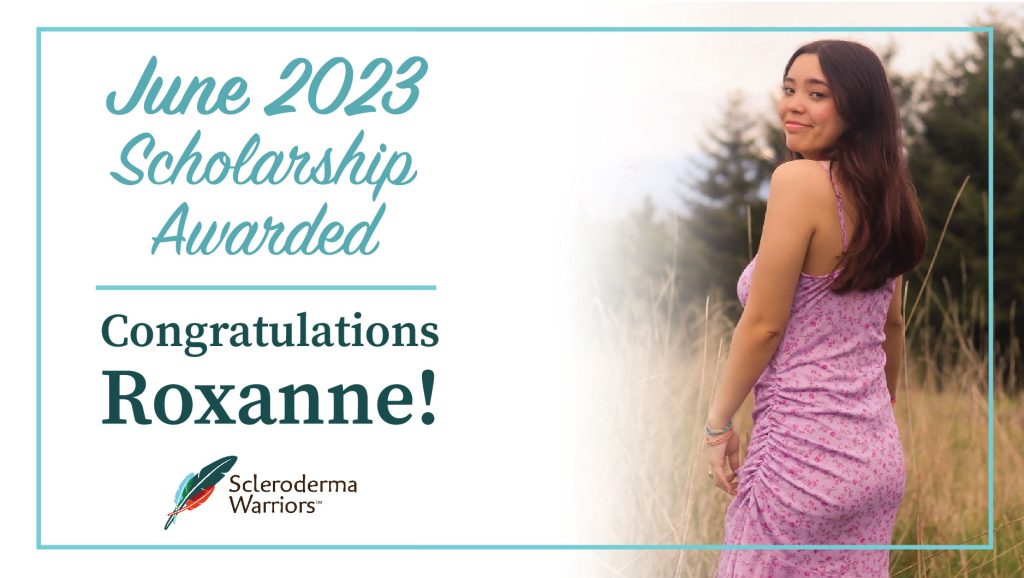Join us in congratulating Roxanne!
Roxanne has been kind enough to allow us to share her essay on our website for others to see. You can read Roxanne’s essay below:
“What’s wrong with your nose?” my Kindergarten best friend asked me. I blinked at her in confusion, not understanding what she meant. Later that day, I arrived home from school and immediately bolted to the bathroom mirror, staring at myself from every angle possible. This was a common question that people ask me. “I don’t know, it’s just like that,” I would respond, ignoring the difficult truth. The truth is that I have been unsymmetrical my entire life.
No one knew what was wrong with me. All they knew was that something was wrong. When I was six years old, my brother and I were placed with a babysitter over the summer while my parents were working. It was up until that summer that I thought I was a normal kid. While babysitting me that summer, my babysitter noticed something very odd about my head and she told my mom about it. Although my head appears ordinary, a head full of hair hides the differences. About half of my head is round and flat as a head should be, but the right half of the top of my head is completely deformed.
Eventually, my parents grew concerned and they took me to my pediatrician. I sat on the hospital bed as they all traced their fingers across my head, staring at me in confusion. Soon after, my pediatrician sent us to a dermatologist who also failed to come up with an explanation. Our last referral was to a children’s rheumatologist in Portland, Oregon. There, I met Dr. Lasky, who I have now seen every three months for the past eleven years of my life. After bouncing from doctor to doctor and remaining a medical mystery, Dr. Lasky was able to find the reasoning behind my misshapen nostrils, the crater in my skull, and the dents across my forehead.
At the age of seven, I was diagnosed with Parry Romberg syndrome, a type of linear scleroderma. I was a young child, and my doctor’s first Scleroderma patient ever.
Dr. Lasky further explained that Scleroderma was also the reason why my nostrils were two different shapes and why I seemed to get sick incredibly easily. From then on, the abnormalities that my family and I questioned about myself began to make more sense.
I spent my entire childhood avoiding physical contact, praying and begging that no one would touch my head and ask what was wrong. Each time someone touched it and realized that there was something wrong, they would jerk back their hand in disgust and confusion. I hated feeling different. I hated how being sick was the topic of every conversation.
Throughout elementary and middle school, my immune system was incredibly low. I would catch a virus from even the slightest exposure at school. Even the common flu had harsh impacts on my health despite the fact that it hardly affected those that I got it from. I was absent from school for long periods of time, recovering from my illnesses and taking trips to the hospital.
When I was nine, things got worse and I started getting migraines several times a month. The first time I had a migraine started off as a regular day until a raging pain hit my head, my arms went numb, and my vision went blurry. I tried to fight through the discomfort and continue taking notes in class, but I could not see the board and I could not even hear what my teacher was saying. A wave of nausea hit me suddenly and I bolted out of the classroom, grabbing a trash can as I ran into the hall. The same instances constantly occurred throughout elementary and middle school. The migraines would hit randomly and the only way to feel better was to go home and wait for it to pass.
Classmates constantly questioned why I was always sick and why I looked the way I did. Each doctor visit felt as if I was an actor performing center stage with lights and eyes beaming down on me from every direction.
Even with close friends, being chronically ill was something that I hid. Explaining my illness felt like sitting in a zoo while all the visitors pressed their fingers on the glass, pointing and asking questions. Along with the daily dose of teenage insecurities that I consumed, I had an extra reason to pick apart at my imperfections: I was different.
I often felt helpless and would do anything to fit in. I went above and beyond to look and act like the rest of my peers. As a child, I thought that the best option was to hide who I was and to run from the labels chasing me around. I was so young, but constantly changed my appearance to distract myself from the insecurities which set me apart. Growing up with my illness made it incredibly hard to love and accept myself.
When I was in third grade, my doctor sent me to the local clinic every Thursday for a weekly round of a Mycophenolate steroid treatment. Every week, I sat in the same chair for an hour as the cold chill of medicine was being pumped through my veins. It slowly flowed up my arms, sucking out every ounce of light from my eyes. My body was shutting down like a machine and my joyous childhood was being replaced with one of dullness and caution.
Instead of spending my time after school with friends or playing outside, my days were consumed in hospital rooms where my only forms of entertainment were a barely functioning television and my views from the fifth-floor window. I felt like I was trapped in a prison cell, watching the scenes below. Typical seven year olds shouldn’t have MRI sounds memorized and the tastes of hospital food stirring in their stomachs.
I felt useless, like a body consuming space. I thought that I was burdening my parents with my illness and I felt guilty for all that I put them through. The hospital bills were piling up, but my condition never seemed to improve. I hated how I looked and I hated how I felt.
I even had doctors telling my eight-year-old self about the plastic nose surgeries that I could get in the future. Eight-year-olds should be looking forward to a game of four-square, not which type of nose they could get.
When I was nine, my doctor prescribed me daily pills to boost my immune system. The medicine did not improve my condition much—it was merely a precaution to prevent it from worsening. In the fifth grade, I read The Giver for the first time and I was inspired to conduct a similar experiment as the characters in the novel did. I stopped taking my medicine, hypothesizing that my life would drastically change without them. To my surprise, nothing changed and my doctor scorned me, assuring me that the medicine was benefiting me even if I could not see physical changes. Eventually, I adopted a similar view for life.
When I felt like I was struggling in life, I reminded myself that I needed to remain optimistic that everything would become better even if I could not physically see a difference at the moment. Despite how badly I longed for a normal childhood where I didn’t spend my Thursdays cooped up in a hospital with steroids pumping through my veins, I knew that I just had to deal with it. If anything, my illness was more of a battle with myself and caring about what others thought rather than a battle with the illness itself.
Naturally, as a teenager with a disease that is most common in middle-aged adults, I have never met anyone with the same illness as me. Being a moth in a swarm of butterflies was a phenomenon I had to adapt to early on. Growing up with my illness taught me the importance of wanting to be different and embracing my differences instead of just being different.
As I entered the world into various communities, I brought my unique qualities with me. Although it can be challenging, being comfortable in one’s skin is one of the most important things you can be. At the end of the day, I see so much more love around me when I show myself kindness and acceptance.
–Roxanne


